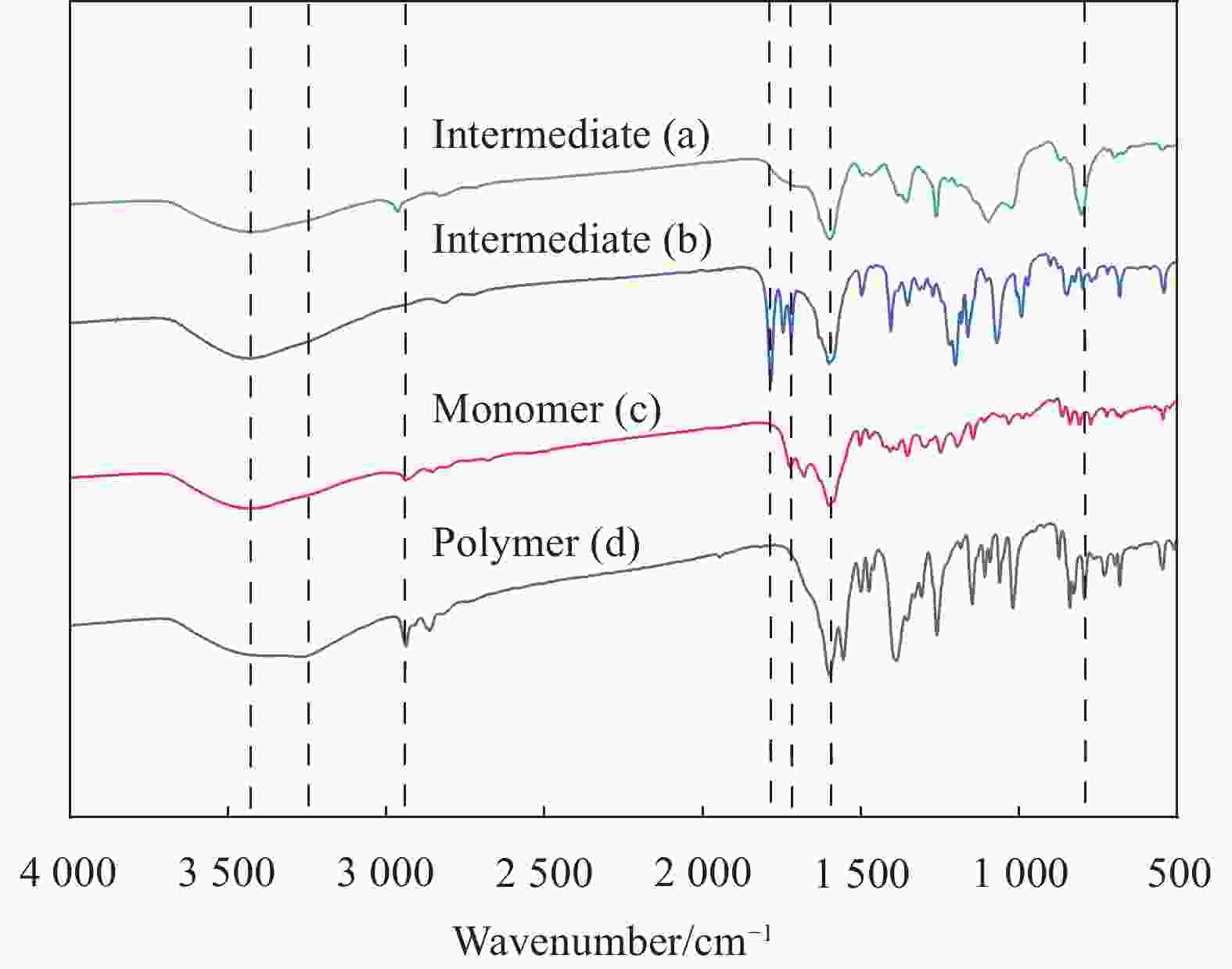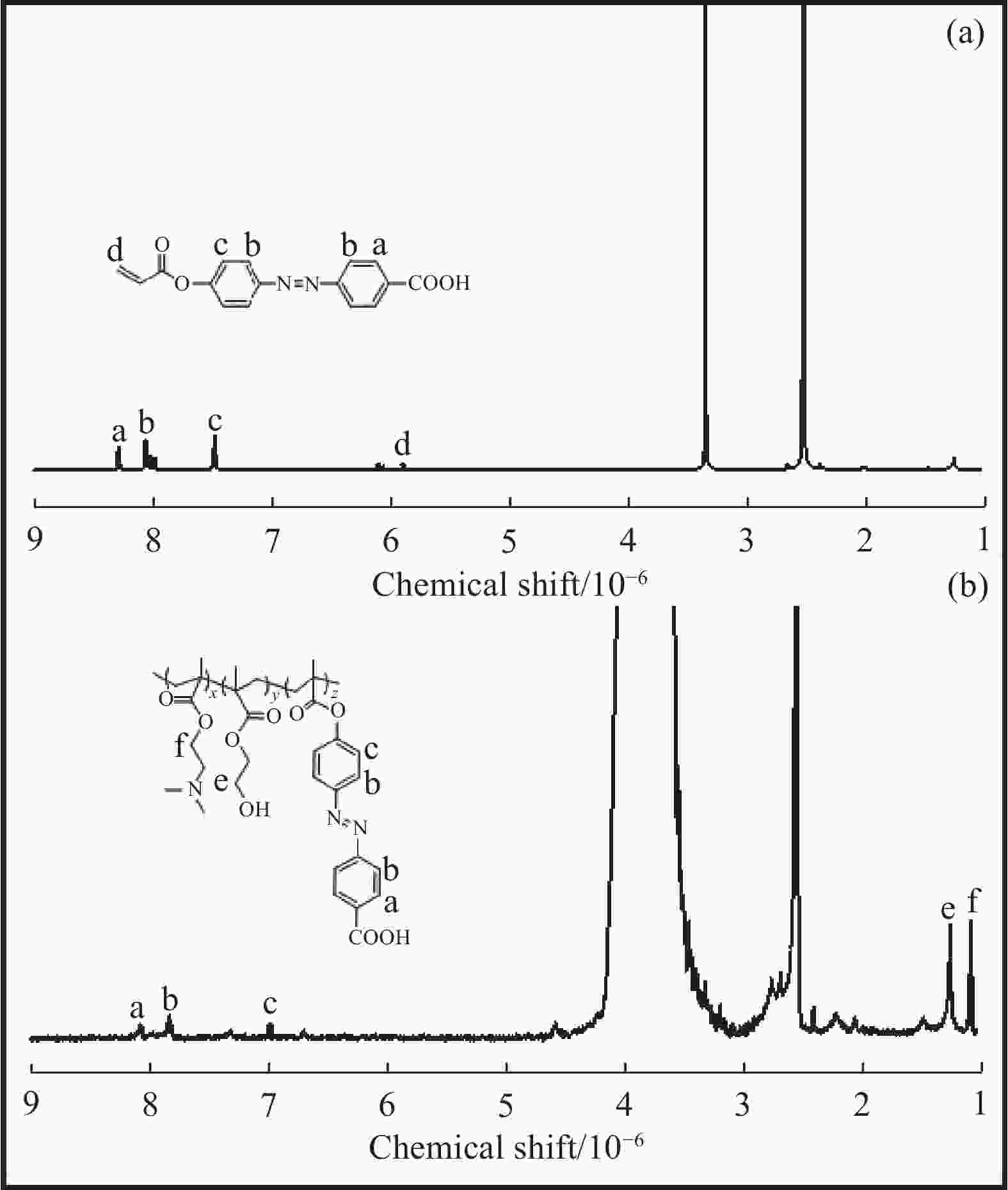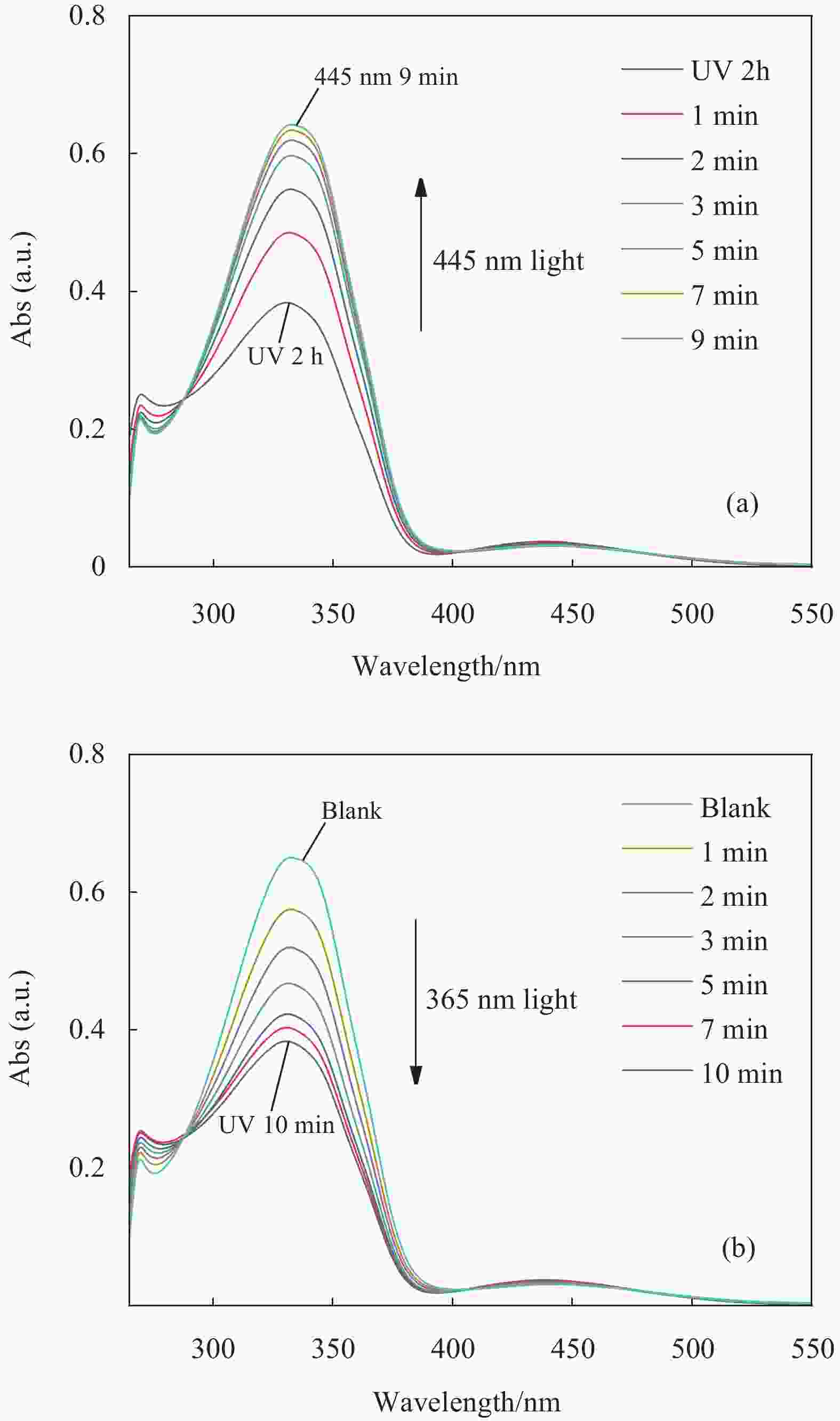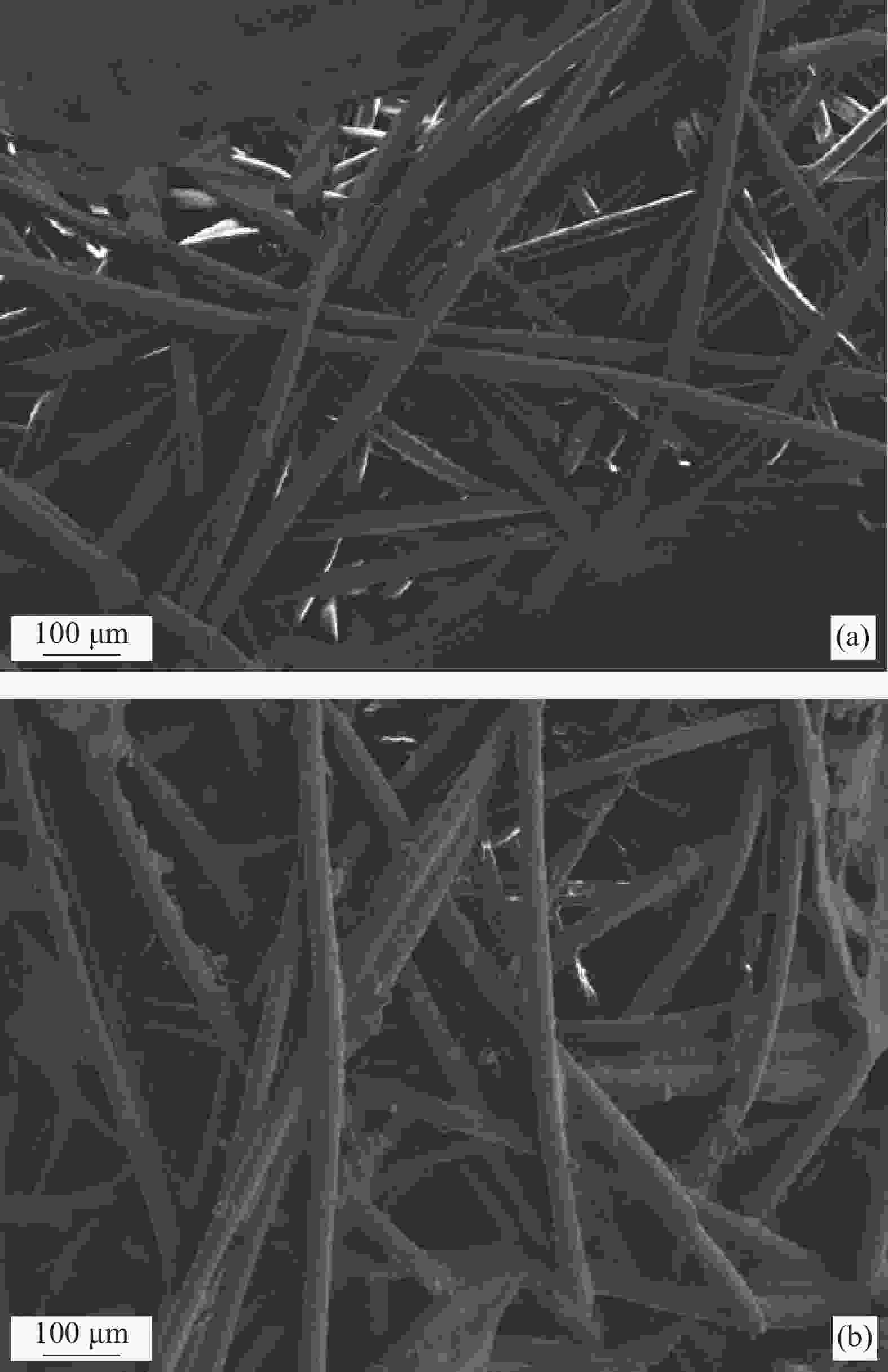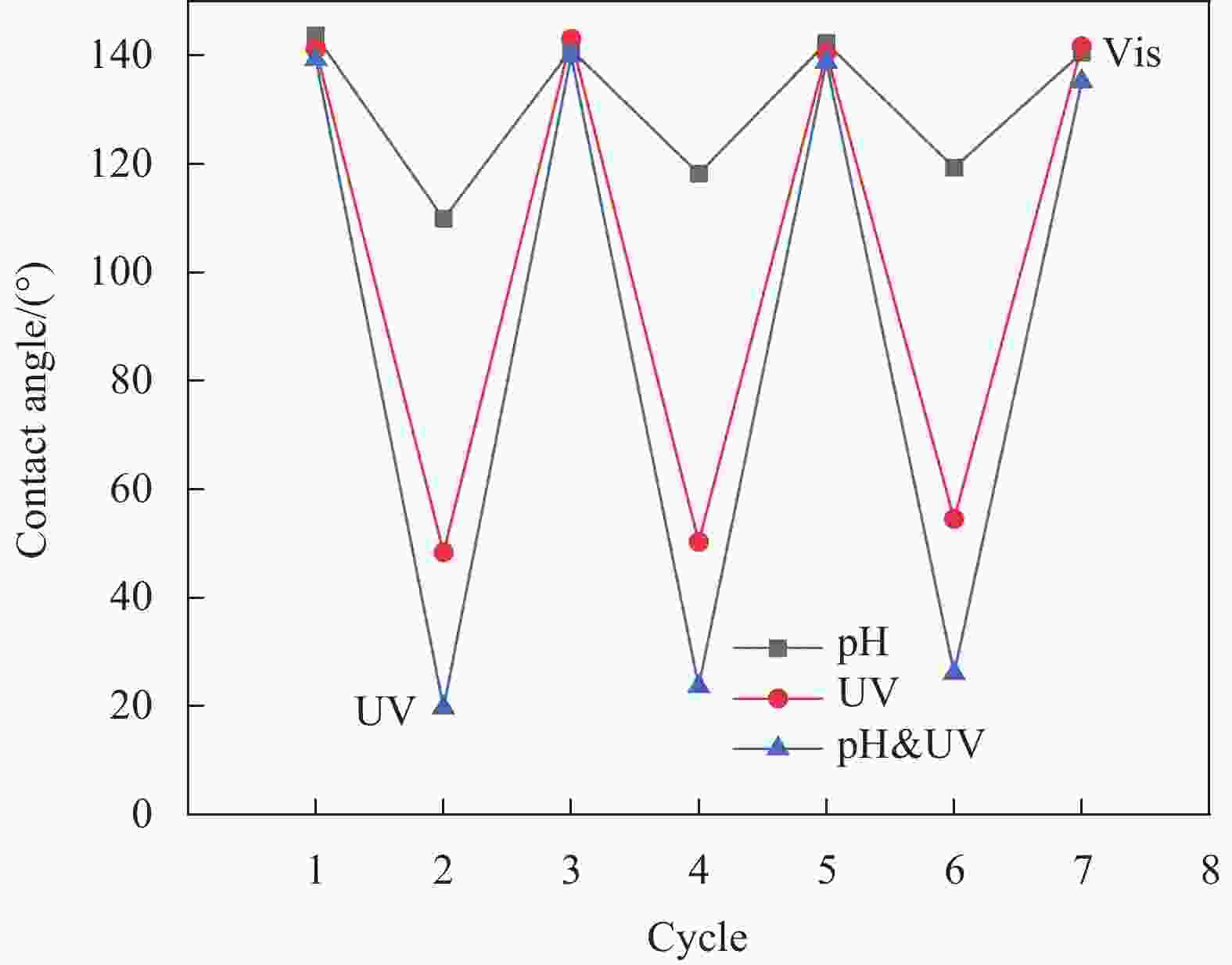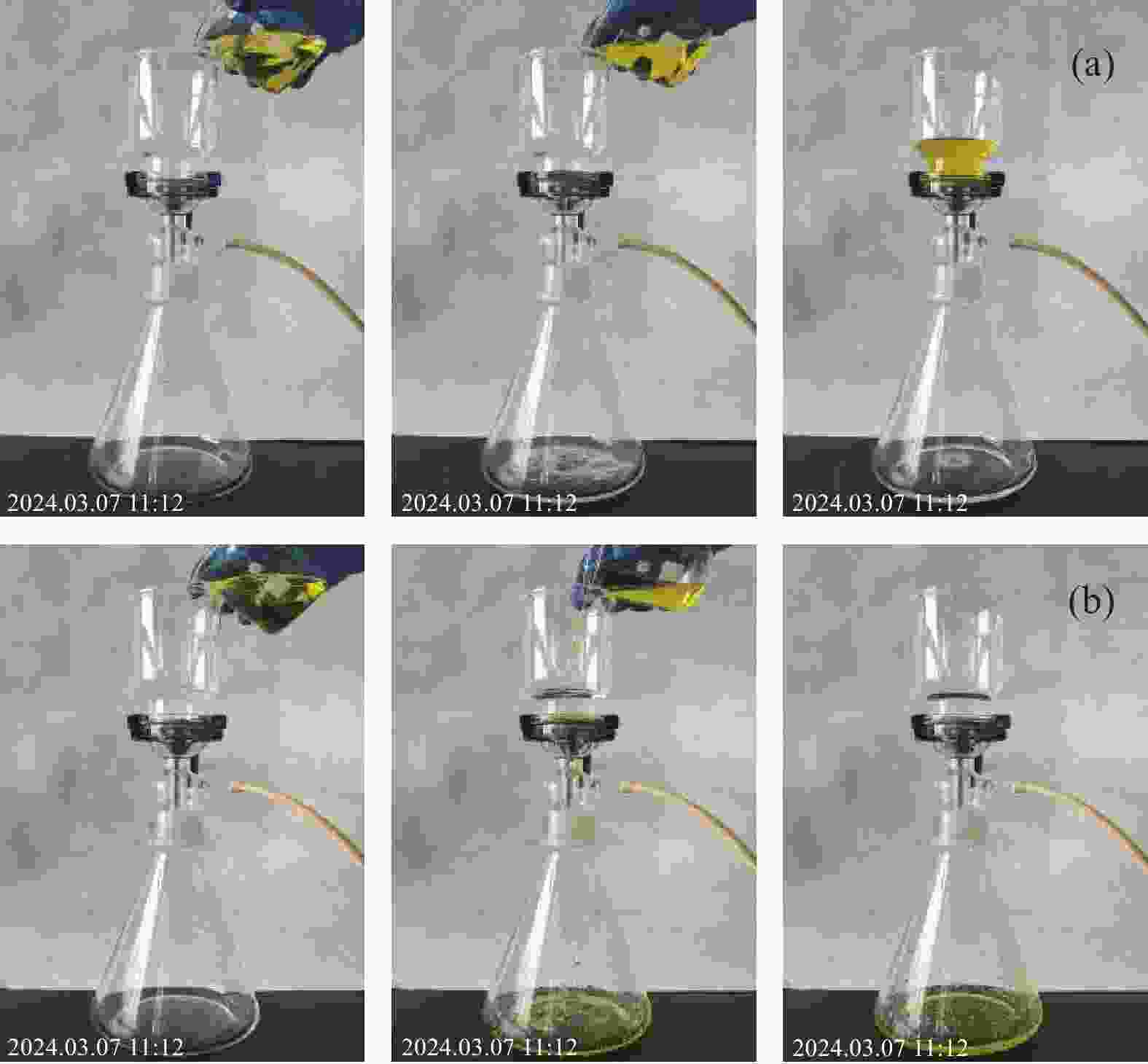Synthesis of smart dual-response oil-water separation material
-
摘要: 智能材料是一种具有感知、响应和适应环境能力的材料。随着科技的不断发展,智能材料在各个领域的应用越来越广泛,未来的发展前景十分广阔。本文合成了一种含有羧基及可聚合基团的偶氮苯化合物,以该偶氮苯化合物作为光响应单元,甲基丙烯酸二甲氨乙酯作为pH响应单元,采用可逆加成-断裂链转移(RAFT)聚合与甲基丙烯酸羟乙酯进行一步共聚,得到了光和pH智能双响应三元共聚物。聚合物涂层在不同条件的刺激下接触角最大变化可达120.2°,经过亲水-疏水的多次转换,接触角仍可以恢复到初始状态,具有优异的可逆刺激响应能力。将聚合物涂敷在无纺布上制成光/pH双响应油水分离膜,该膜在亲油疏水与亲水疏油之间发生可逆转变,实现选择性油水分离,单次分离效率分别达96.3%和95.8%。这种对光和pH的刺激响应性使其可用于复杂环境的液体传输和油水分离等领域,具有巨大的智能水油分离应用潜力。Abstract: Smart materials are materials that have abilitys to sense, respond and adapt to their environments. With the continuous development of science and technology, smart materials are more and more widely used in various fields, and have very broad prospects for development in the future. In this paper, one kind of azobenzene compound containing polymerizable groups was synthesized. This azobenzene compound was used as photoresponsive unit and dimethylaminoethyl methacrylate as a pH responsive unit, they can copolymerize with hydroxyethyl methacrylate to form terpolymer by one step reversible addition-fragmentation chain transfer polymerization (RAFT) method, which has smart dual response to light and pH. When stimulated by different conditions, the maximum contact angle change of the polymer coating can reach 120.2°, and the contact angle can still restore to the initial state after multiple transformations between hydrophilic and hydrophobic. It shows that the material has excellent reversible stimulus responsiveness ability. When the polymer was coated on the non-woven fabric to make light /pH dual-responsive oil-water separation membrane, it can undergo a reversible transition between hydrophilic and hydrophobic, so as to achieve the selective separation of oil and water, the single separation efficiency can reach 96.3% and 95.8%, respec-tively. This kind of stimulus responsibility to light and pH can be used in areas such as liquid transport and oil-water separation in complex environments, and have great potential for smart water-oil separation application.
-
图 6 聚合物d的载玻片涂层在不同条件下的接触角变化: (a) 自然条件下; (b) 经pH=3缓冲溶液浸泡后; (c) 经pH=10缓冲溶液浸泡后; (d) 经365 nm光照射后; (e) 经445 nm光照射后; (f) 经pH=3缓冲溶液浸泡并用365 nm紫外光照射后
Figure 6. Contact angle variation of polymer d slide coatings under different conditions: (a) the natural state; (b) after immersion with pH=3 buffer solution; (c) after immersion in pH=10 buffer solution; (d) after exposure to 365 nm light; (e) after exposure to 445 nm light; (f) after immersion in pH=3 buffer solution and irradiation with 365 nm ultraviolet light
-
[1] GUO H, QIN Q, HU M, et al. Treatment of refinery wastewater: Current status and prospects[J]. Journal of Environmental Chemical Engineering, 2024, 112508. [2] LARI K S, DAVIS G B, BASTOW T, et al. On quantifying global carbon emission from oil contaminated lands over centuries[J]. Science of The Total Environment, 2024, 907: 168039. doi: 10.1016/j.scitotenv.2023.168039 [3] 吴应湘, 许晶禹. 油水分离技术[J]. 力学进展, 2015, 45: 179-216. doi: 10.6052/1000-0992-15-001WU Yingxiang, XU Jingyu. Oil-water separation technology[J]. Advances in Mechanics, 2015, 45: 179-216(in Chinese). doi: 10.6052/1000-0992-15-001 [4] CHANG L, CAO Y, FAN G, et al. A review of the applications of ion floatation: wastewater treatment, mineral beneficiation and hydrometallurgy[J]. RSC Advances, 2019, 9: 20226-20239. doi: 10.1039/C9RA02905B [5] 陈明功, 周鑫, 赵彬彬等. 油水分离技术的研究进展[J]. 现代化工, 2024, 44(1): 63-67.CHENG Minggong, ZHOU Xin, ZHAO Binbin et al. Research progress of oil-water separation technology[J]. Modern Chemical Industry, 2024, 44(1): 63-67(in Chinese). [6] MANSOUR M S, ABDEL-SHAFY H I, IBRAHIM A M. Petroleum wastewater: Environmental protection, treatment, and safe reuse: An overview[J]. Journal of Environmental Management, 2024, 351: 119827. doi: 10.1016/j.jenvman.2023.119827 [7] 胡天佑, 唐瑾, 陈志莉. 石油工业含油废水处理进展[J]. 水处理技术, 2021, 47(06): 12-17.HU Tianyou, TANG Jin, CHEN Zhili. Progress in the treatment of oily wastewater from petroleum industry[J]. Water Treatment Technology, 2019, 47(06): 12-17. (in Chinese) [8] ADETUNJI A I, OLANIRAN A O, Treatment of industrial oily wastewater by advanced technologies: a review,[J]. Applied Water Science, 2021, 11(6): 98. [9] 徐诗琪, 周洲, 汤睿, 等. 高疏水纳米纤维素-壳聚糖/膨润土气凝胶的构建及其高效油水分离的应用[J]. 复合材料学报, 2024, 41(3): 1347-1355.XU Shiqi ZHOU Zhou, TANG Rui, et al. Construction of highly hydrophobic nanocellulose-chitosan/bentonite aerogel and its application of efficient oil-water separation[J]. Acta Materiae Compositae Sinica, 2024, 41(3): 1347-1355(in Chinese). [10] YANG H, ZHANG Y, HUANG C, et al. Antifouling multi-functional membrane for oil/dye wastewater treatment: Regeneration while treating mixed pollutants[J]. Separation and Purification Technology, 2024, 332: 125804. doi: 10.1016/j.seppur.2023.125804 [11] LI B, QI B, GUO Z, et al. Recent developments in the application of membrane separation technology and its challenges in oil-water separation: A review[J]. Chemosphere, 2023, 138528. [12] ZHANG J, PENG K, XU Z, et al. A comprehensive review on the behavior and evolution of oil droplets during oil/water separation by membranes[J]. Advances in Colloid and Interface Science, 2023, 319: 102971. doi: 10.1016/j.cis.2023.102971 [13] 穆蒙, 宁学文, 罗新杰等. 刺激响应性聚合物微球的制备、性能及应用[J]. 化学进展, 2020, 32(07): 882-894.MU Meng, NING Xuewen, LUO Xinjie et al. Preparation, properties and application of stimulus-responsive polymer microspheres[J]. Advances in Chemistry, 2019, 32(07): 882-894(in Chinese). [14] GONG J, XIANG B, SUN Y, et al. Janus smart materials with asymmetrical wettability for on-demand oil/water separation: a comprehensive review[J]. Journal of Materials Chemistry A, 2023, 11: 25093-25114. doi: 10.1039/D3TA04160C [15] QIU L, ZHENG J, YU X, et al. Hydrophobic photore-sponsive azobenzene-containing materials prepared by click reac-tion[J]. Surface Review and Letters, 2023, 2450055. [16] YU B, HOU K, FAN Z, et al, Design fiber-based membrane with interfacial wettability rapidly regulated behavior by pH for oily wastewater high-efficient treatment[J]. Progress in Organic Coatings, 2024, 189: 108326. [17] ZHONG Q, LU M, NIEUWENHUIS S, et al, Enhanced Stain Removal and Comfort Control Achieved by Cross-Linking Light and Thermo Dual-Responsive Copolymer onto Cotton Fabrics[J]. ACS Applied Materials & Interfaces, 2019, 11: 5414-5426. [18] CHEN W, HE H, ZHU H, et al, Thermo-Responsive Cellulose-Based Material with Switchable Wettability for Controllable Oil/Water Separation[J]. Polymers, 2018, 10(6): 592. [19] SUN R, WU C, HOU B, et al. Magnetically Responsive Superhydrophobic Surface with Reversibly Switchable Wettability: Fabrication, Deformation, and Switching Performance[J]. ACS Applied Materials & Interfaces, 2023, 15(45): 53146-53158. [20] LIU X, ZHANG P, SONG H, et al. Unveiling a pH-Responsive Dual-Androgen-Blocking Magnetic Molecularly Imprinted Polymer for Enhanced Synergistic Therapy of Prostate Cancer[J]. ACS Applied Materials & Interfaces, 2024, 16(4): 4348-4360. [21] SURAPANENI S G, CHOUDHARI S N, AVHAD S V, et al. Permeable polymersomes from temperature and pH dual stimuli-responsive PVCL-b-PLL block copolymers for enhanced cell internalization and lysosome targeting[J]. Biomaterials Advances, 2023, 151: 213454. doi: 10.1016/j.bioadv.2023.213454 [22] URBAN D, MARCUCCI N, WÖLFLE C H, et al. Polarization-driven reversible actuation in a photo-responsive polymer composite[J]. Nature Communications, 2023, 14(1): 6843. doi: 10.1038/s41467-023-42590-y [23] LI Y, XUE B, YANG J, et al, Azobenzene as a photoswitchable mechanophore[J]. Nature Chemistry, 2023, 1-10. [24] DU Q, ZHAO J, JIANG L, et al. Molecular design on dual stimuli-responsive azobenzene-containing ionic complexes toward self-healing materials under photoirradiation or humid condition at room temperature[J]. Applied Materials Today, 2023, 35: 101945. doi: 10.1016/j.apmt.2023.101945 [25] LI B H, JIANG L, WANG Y, et al. Construction and Properties of New-Type Photo-Responsive Molecular Imprinting Materials[J]. Polymer Science, Series A, 2023, 64: 673-684. [26] 陈佳慧, 袁晨瑞, 吴泽宏等. 偶氮苯高分子光控可逆黏合剂的制备及性能[J]. 功能高分子学报, 2023, 36(03): 293-301.CHEN Jiahui, YUAN Chenrui, WU Zehong et al. Preparation and properties of photocontrolled reversible adhesives for azobenzene polymers[J]. Journal of Functional Polymers, 2019, 36(03): 293-301(in Chinese). [27] YANG Q, GE J, QIN M, et al, Controllable heat release of phase-change azobenzenes by optimizing molecular structures for low-temperature energy utilization[J]. Science China Materials, 2023, 66: 3609-3620. [28] MERRITT D C I, JACQUEMIN D, VACHER M. cis → trans photoisomerisation of azobenzene: a fresh theoretical look[J]. Physical Chemistry Chemical Physics, 2021, 23: 19155-19165. doi: 10.1039/D1CP01873F [29] YANG X, JIN H, TAO X, et al. Photo-switchable smart superhydrophobic surface with controllable superwettability[J]. Polymer Chemistry, 2021, 12(37): 5303-5309. doi: 10.1039/D1PY00984B [30] DU Z, REN B, CHANG X, et al. Aggregation and Rheology of an Azobenzene-Functionalized Hydrophobically Modified Ethoxylated Urethane in Aqueous Solution[J]. Macromolecules, 2016, 49(13): 4978-4988 doi: 10.1021/acs.macromol.6b00633 [31] CHENG H B, ZHANG S, QI J, et al. Advances in Application of Azobenzene as a Trigger in Biomedicine: Molecular Design and Spontaneous Assembly[J]. Advanced Materials, 2021, 33: e2007290. doi: 10.1002/adma.202007290 -

 点击查看大图
点击查看大图
计量
- 文章访问数: 76
- HTML全文浏览量: 40
- 被引次数: 0




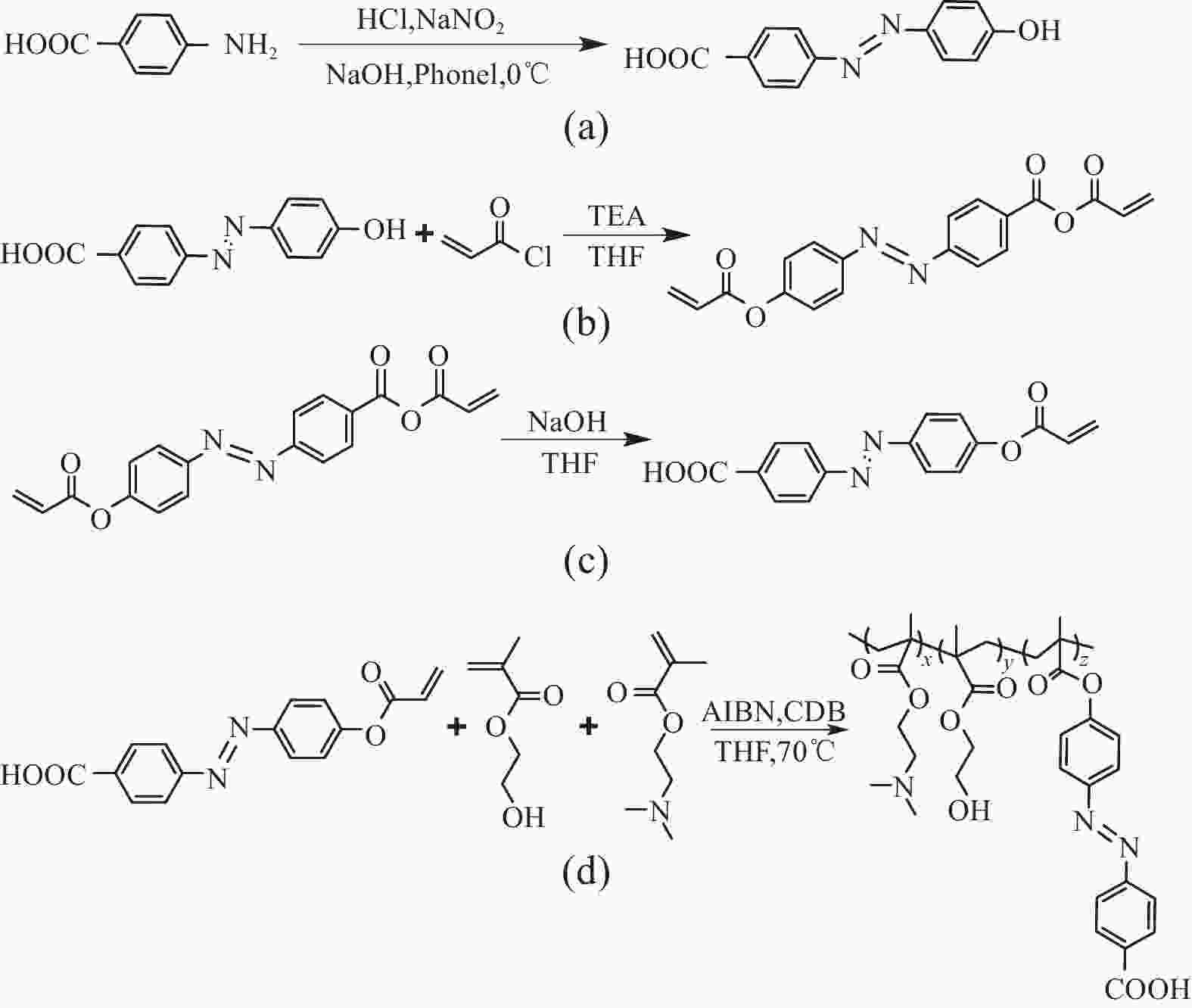
 下载:
下载:
